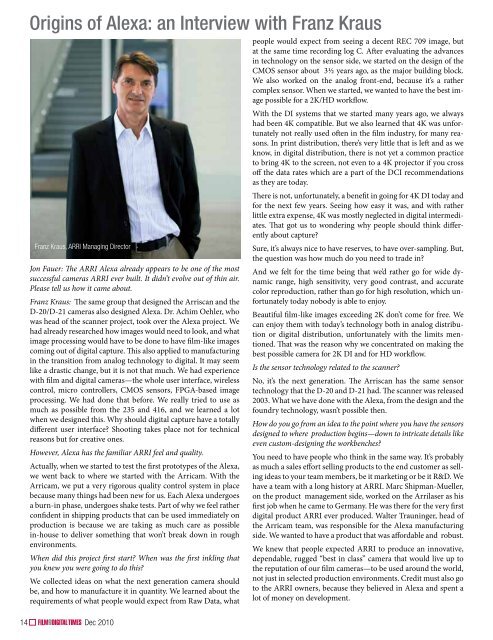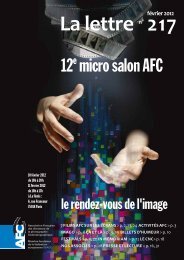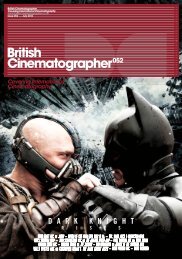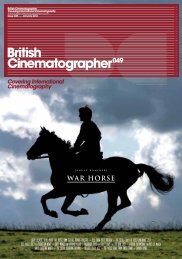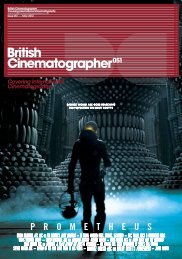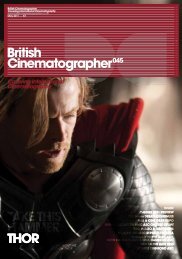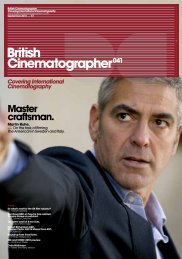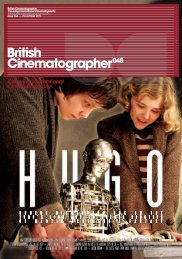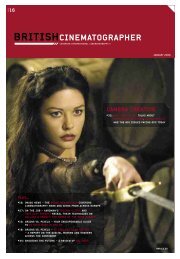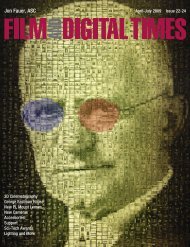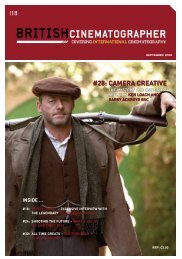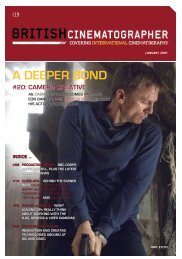Create successful ePaper yourself
Turn your PDF publications into a flip-book with our unique Google optimized e-Paper software.
Origins of Alexa: an Interview with Franz Kraus<br />
people would expect from seeing a decent REC 709 image, but<br />
at the same time recording log C. After evaluating the advances<br />
in technology on the sensor side, we started on the design of the<br />
CMOS sensor about 3½ years ago, as the major building block.<br />
We also worked on the analog front-end, because it’s a rather<br />
complex sensor. When we started, we wanted to have the best image<br />
possible for a 2K/HD workflow.<br />
With the DI systems that we started many years ago, we always<br />
had been 4K compatible. But we also learned that 4K was unfortunately<br />
not really used often in the film industry, for many reasons.<br />
In print distribution, there’s very little that is left and as we<br />
know, in digital distribution, there is not yet a common practice<br />
to bring 4K to the screen, not even to a 4K projector if you cross<br />
off the data rates which are a part of the DCI recommendations<br />
as they are today.<br />
There is not, unfortunately, a benefit in going for 4K DI today and<br />
for the next few years. Seeing how easy it was, and with rather<br />
little extra expense, 4K was mostly neglected in digital intermediates.<br />
That got us to wondering why people should think differently<br />
about capture?<br />
Franz Kraus, ARRI Managing Director<br />
Sure, it’s always nice to have reserves, to have over-sampling. But,<br />
the question was how much do you need to trade in?<br />
Jon Fauer: The ARRI Alexa already appears to be one of the most<br />
successful cameras ARRI ever built. It didn’t evolve out of thin air.<br />
Please tell us how it came about.<br />
Franz Kraus: The same group that designed the Arriscan and the<br />
D-20/D-21 cameras also designed Alexa. Dr. Achim Oehler, who<br />
was head of the scanner project, took over the Alexa project. We<br />
had already researched how images would need to look, and what<br />
image processing would have to be done to have film-like images<br />
coming out of digital capture. This also applied to manufacturing<br />
in the transition from analog technology to digital. It may seem<br />
like a drastic change, but it is not that much. We had experience<br />
with film and digital cameras—the whole user interface, wireless<br />
control, micro controllers, CMOS sensors, FPGA-based image<br />
processing. We had done that before. We really tried to use as<br />
much as possible from the 235 and 416, and we learned a lot<br />
when we designed this. Why should digital capture have a totally<br />
different user interface? Shooting takes place not for technical<br />
reasons but for creative ones.<br />
However, Alexa has the familiar ARRI feel and quality.<br />
Actually, when we started to test the first prototypes of the Alexa,<br />
we went back to where we started with the Arricam. With the<br />
Arricam, we put a very rigorous quality control system in place<br />
because many things had been new for us. Each Alexa undergoes<br />
a burn-in phase, undergoes shake tests. Part of why we feel rather<br />
confident in shipping products that can be used immediately on<br />
production is because we are taking as much care as possible<br />
in-house to deliver something that won’t break down in rough<br />
environments.<br />
When did this project first start? When was the first inkling that<br />
you knew you were going to do this?<br />
We collected ideas on what the next generation camera should<br />
be, and how to manufacture it in quantity. We learned about the<br />
requirements of what people would expect from Raw Data, what<br />
14 Dec 2010<br />
And we felt for the time being that we’d rather go for wide dynamic<br />
range, high sensitivity, very good contrast, and accurate<br />
color reproduction, rather than go for high resolution, which unfortunately<br />
today nobody is able to enjoy.<br />
Beautiful film-like images exceeding 2K don’t come for free. We<br />
can enjoy them with today’s technology both in analog distribution<br />
or digital distribution, unfortunately with the limits mentioned.<br />
That was the reason why we concentrated on making the<br />
best possible camera for 2K DI and for HD workflow.<br />
Is the sensor technology related to the scanner?<br />
No, it’s the next generation. The Arriscan has the same sensor<br />
technology that the D-20 and D-21 had. The scanner was released<br />
2003. What we have done with the Alexa, from the design and the<br />
foundry technology, wasn’t possible then.<br />
How do you go from an idea to the point where you have the sensors<br />
designed to where production begins—down to intricate details like<br />
even custom-designing the workbenches?<br />
You need to have people who think in the same way. It’s probably<br />
as much a sales effort selling products to the end customer as selling<br />
ideas to your team members, be it marketing or be it R&D. We<br />
have a team with a long history at ARRI. Marc Shipman-Mueller,<br />
on the product management side, worked on the Arrilaser as his<br />
first job when he came to Germany. He was there for the very first<br />
digital product ARRI ever produced. Walter Trauninger, head of<br />
the Arricam team, was responsible for the Alexa manufacturing<br />
side. We wanted to have a product that was affordable and robust.<br />
We knew that people expected ARRI to produce an innovative,<br />
dependable, rugged “best in class” camera that would live up to<br />
the reputation of our film cameras—to be used around the world,<br />
not just in selected production environments. Credit must also go<br />
to the ARRI owners, because they believed in Alexa and spent a<br />
lot of money on development.


